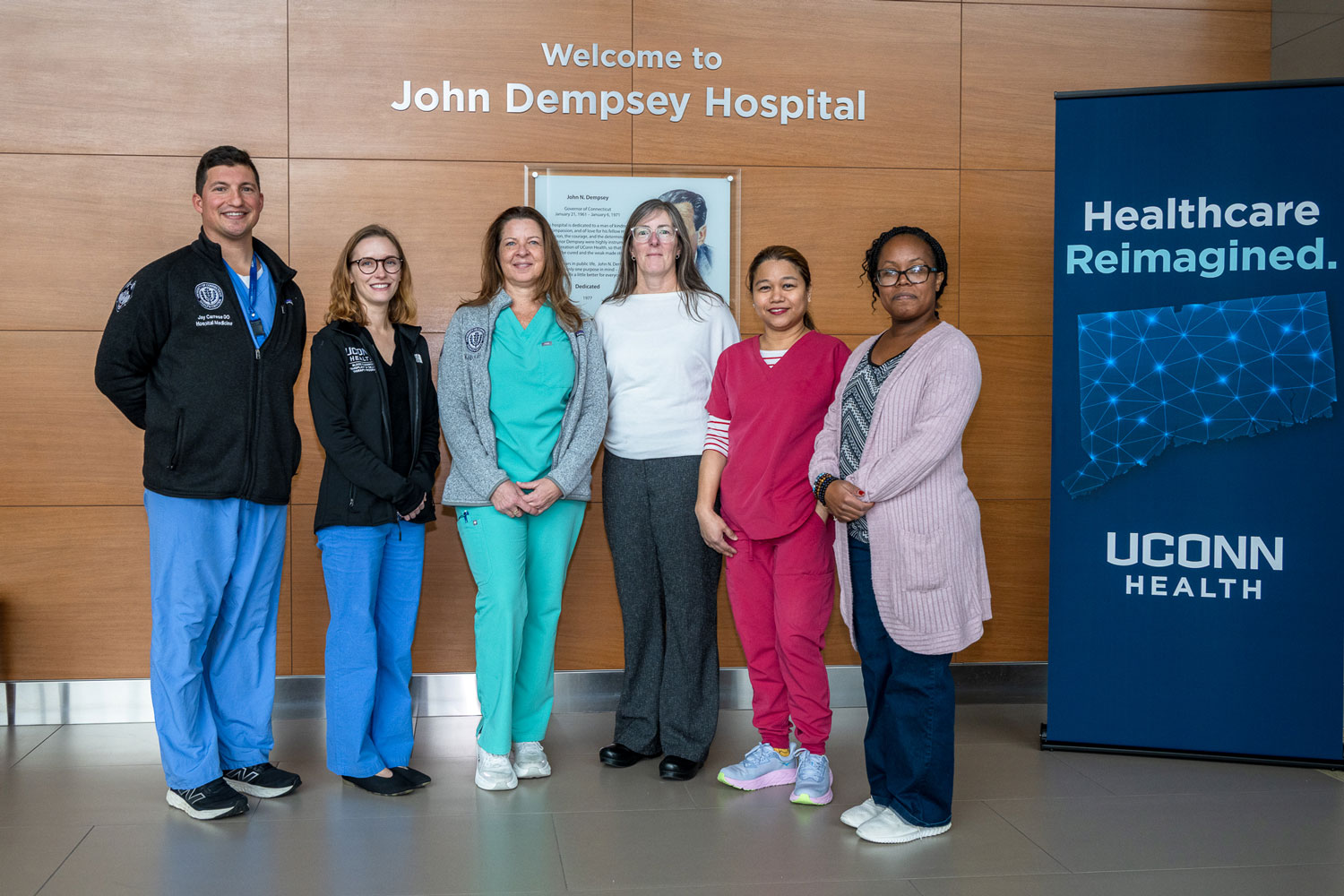The University of Connecticut and University of Rhode Island (URI) were jointly awarded a five-year contract from General Dynamics Electric Boat (GDEB) to provide regional workforce development support to the Maritime Industrial Base.
The ANCHOR (Advancing Naval Careers through Higher-ed Outreach and Research) grant was celebrated in a launch event at UConn Avery Point on April 3. Representatives from UConn, URI, GDEB, and local and state governments were present to support the extensive program.
The contract will support ongoing activities and drastically expand the work of the UConn-URI Navy STEM Coalition, which, since 2017, has developed a K-16 pipeline across southern New England to encourage both the skilled trades and engineering careers needed to build submarines.
The UConn-URI Navy STEM Coalition was established in 2017 through the leadership of Michael Accorsi at UConn and David Taggart at URI via funding from the Office of Naval Research. In 2021, the program was expanded under the current leadership of Alexandra Hain at UConn and Valerie Maier-Speredelozzi at URI, through a grant from the DoDSTEM National Defense Education Program. Hain and Maier-Speredelozzi will continue as the institutional leads of the contract.
U.S. Rep. Joe Courtney, whose Congressional district includes southeastern Connecticut, also attended Thursday.

“There’s no question that shipyard workloads’ are going to continue well into the 2040s,” Courtney said. “That means the people that are going to be working the yards are in grade schools today… That’s really what is the genius about this whole initiative. It’s to get undergraduate engineering students into young classrooms, because that’s really where the magic is.”
U.S. Sen. Jack Reed (D-RI) was unable to attend the event, but sent his regards for the UConn-URI Navy STEM Coalition via a letter recited that evening.
UConn and URI Engineering leadership were pleased by the partnership and the renewed contract.
“By working alongside URI and General Dynamics Electric Boat, we are not only advancing naval engineering and skilled trades but also inspiring a pipeline of talent to meet the demands of this vital sector,” said UConn Engineering Dean JC Zhao. “The coalition’s efforts will have a substantial impact on southern New England and beyond, ensuring that our students and workforce are equipped to lead in submarine production and innovation for decades to come.”
“The Eastern Connecticut and Rhode Island region – which includes two public flagship research universities, GDEB’s campuses in Groton and Quonset Point, and U.S. Navy operations in New London and Newport – is the undisputed global epicenter of submarine research, development and manufacturing,” said URI Engineering Dean Anthony Marchese. “For decades, UConn and URI have responded to the research and workforce development needs of our regional Maritime Industrial Base partners and we are proud to continue to fulfill that mission through the ANCHOR program.”
In the last three years, the coalition has steadily increased its presence across southern New England, engaging over 13,000 students in the fundamentals of naval science and engineering. The Navy STEM Coalition’s staff and engineering university student members have taught Connecticut and Rhode Island students the fundamentals of buoyancy, additive manufacturing, and the core trades essential to submarine production through over 75 regional classroom visits and more than 20 large-scale outreach events nationwide. The coalition has also engaged and trained dozens of teachers through programs ranging from day-long workshops to year-long residencies.

Maier-Speredelozzi said, “Inspiring undergraduates and K-12 students to pursue STEM careers is always rewarding, and we are excited to expand our outreach with K-12 teachers. When we work with teachers, we magnify the impact to include not only the students in their classes today, but also for years to come.”
Looking forward, the ANCHOR contract will enable the coalition to significantly increase activities in the region, including the development of multiple new summer programs at both campuses for K-12 students, undergraduate summer researchers, and pre-service teachers.
Thursday’s event also included the recognition of several URI and UConn students. The UConn winners included: Adeline Smith for the Naval Engineering Achievement Award, Jada Veracosa for the Navy STEM Excellence in Engineering Education Award, and Oliver MacKinnon for the Naval STEM Rising Star Award.
The URI winners included: Olivia Daniello for the Navy STEM Excellence in Education Award, Sam Miller for the Naval Engineering Achievement Award, Hope Kelley for the Naval STEM Rising Star Award, and Megan Gimple for the Naval STEM Graduate Student Award.
Regarding the growth of K-12 summer programming, Hain said, “Through targeted summer programs in engineering and skilled trades, we are committed to preparing students for careers in the submarine industrial base. By offering partial and full scholarships, along with free options, we’re dedicated to inspiring and equipping the next generation of talent, breaking down barriers to ensure that a skilled workforce is ready to meet the unique demands of submarine production and innovation.”
The coalition will also offer significant funding for those already working within the industrial base to come back to either UConn or URI for graduate school in a partnership with the National Institute for Undersea Vehicle Technology, the premier fundamental research facility for submarine development in the region.
In expanding to support GDEB and the wider industrial base, the coalition will establish a comprehensive pipeline for submarine production from elementary education to graduate school, ensuring students in southern New England are supported in their path to building the future of the underwater fleet.

“The UConn-URI Navy STEM Coalition recognizes the critical support from the ANCHOR contract, managed by General Dynamics Electric Boat and funded by the U.S. Navy through the Maritime Industrial Base Program, which enables continued investment in workforce development and STEM education,” said Erica Logan, the U.S. Navy’s Maritime Industrial Base Deputy Director of Workforce.
With the United States Navy indicating that the Maritime Industrial Base will need over 150,000 new employees in the next decade to meet procurement demands, the submarine sector will be vibrant for decades to come. Once called “the Silicon Valley of undersea warfare” by former Secretary of Defense Chuck Hagel, southern New England is set to see much of that growth, and thus is in vital need of the pipeline development GDEB and the coalition will be achieving through this partnership.
“The ANCHOR program demonstrates the power of public institutions investing in their local communities and their student body by leveraging the private sector of the Maritime Industrial Base,” said Sean Morrone, Electric Boat’s Manager of Supplier and Workforce Development. “Partnerships like this create a sustainable impact on the economic growth and community well-being of our region.”
Meeting the needs of the Maritime Industrial Base at this time requires innovative collaborations between industry, government, and academia, and the coalition is eager to continue inspiring the next generation to “build giants.”



